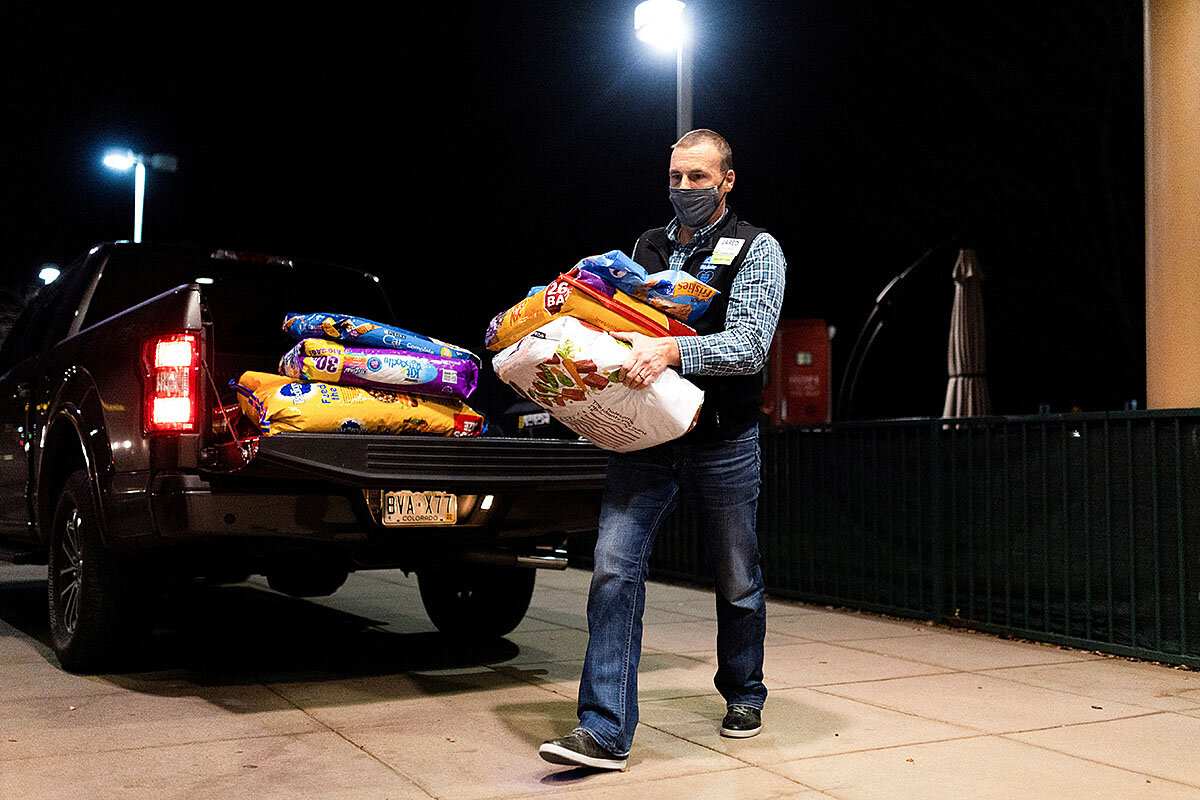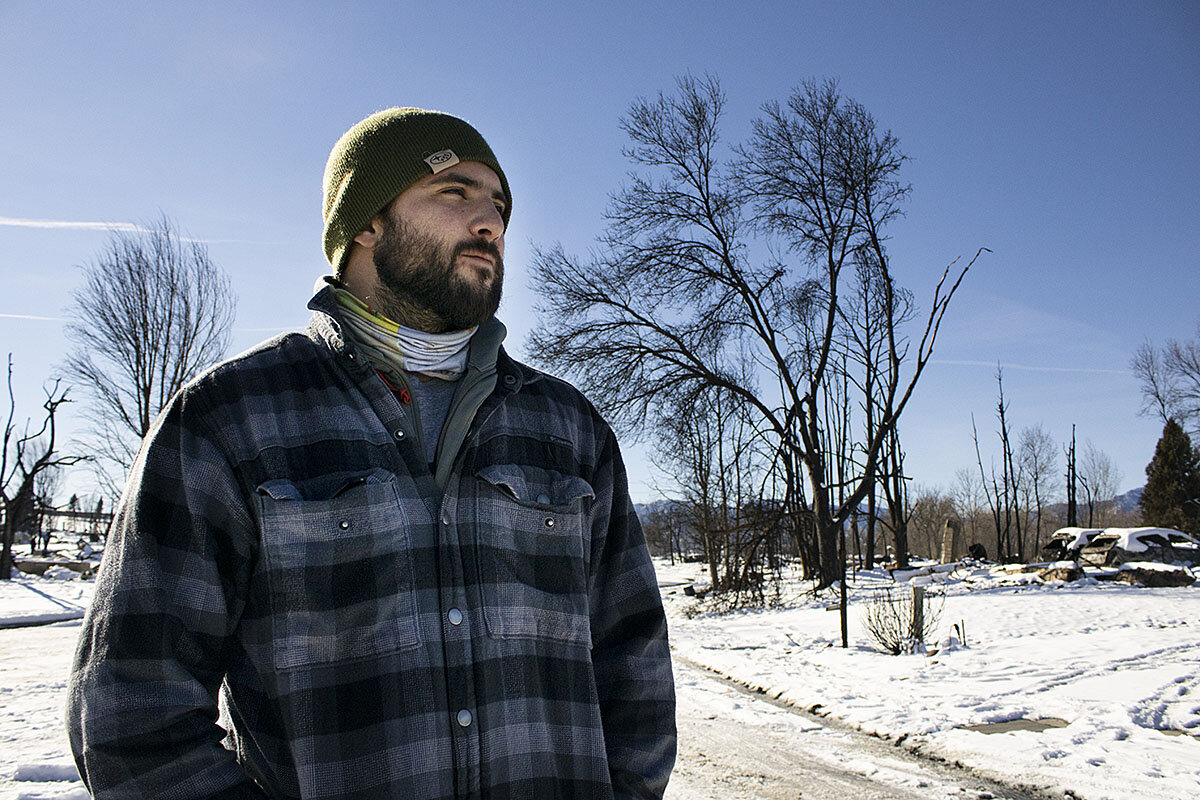‘How can I help?’ After fire, Coloradans’ generosity lifts neighbors.
Loading...
| Louisville, Colo.
On the first day of the new year, Stephen Boatright treated his 6-year-old to pancakes for her birthday. Later that day, they went to Build-a-Bear Workshop on a mission: to replace a stuffed animal lost in Colorado’s Marshall Fire.
Far more than the bear had been lost. Just about everything, really. The Boatrights, like hundreds of other Colorado families, had lost their home in the waning days of 2021.
Last Thursday, in a matter of minutes, Mr. Boatright saw the gray sky turn black with smoke. He and his wife, three children, and visiting relatives fled the Sagamore neighborhood in Superior, Colorado, to a hotel as the Marshall Fire spread.
Why We Wrote This
In the wake of the Marshall Fire, thousands of Coloradans have begun the new year rebuilding their lives. For some locals, acts of kindness soothe the uncertainty.
All 370 houses in their subdivision reportedly went up in flames. “Pretty tough to kind of do the mental inventory and know what’s gone,” says Mr. Boatright.
There’s irony, too. The family’s experience last week echoed 2017, when they evacuated their previous place in California during the Tubbs Fire. Motivation for moving here, he says.
And yet, the generosity of strangers helped celebrate his daughter’s special day. Beyond a GoFundMe launched by relatives and donations like clothes, strangers dropped off birthday presents specifically for her: gift-wrapped books, cards signed by kids, a rainbow unicorn cake. Though a bit young to understand it all, she was excited, says her dad.
Much remains unclear in the aftermath of the blaze that evacuated 35,000 people: when residents can safely return, how the fire started, how to rebuild lives. But some locals say acts of kindness are soothing the uncertainty.
“I think the outpouring is the only thing holding us together,” says Mr. Boatright.
Child care and ash sifters
In terms of buildings burned, the Dec. 30 Marshall Fire is considered the most destructive in the state’s history. Flames torched some 6,000 acres, destroying at least 991 homes and other structures primarily in Superior and Louisville. As of Monday afternoon, the cause remains under investigation, according to Boulder County Sheriff Joe Pelle, and two people are still confirmed missing. Recent heavy snowfall and debris have complicated searches.
Colorado is no stranger to wildfires. Near-record-low precipitation and warm temperatures – the latter aided by climate change – had parched the suburban grassland area, says Andy Hoell, a drought expert at the National Oceanic and Atmospheric Administration’s Physical Sciences Laboratory. The blaze was driven by winds at times over 100 mph.
Solidarity, meanwhile, was also gathering speed. People began mobilizing over social media to help connect evacuees to missing pets. By the weekend, over $1 million had been raised for the Boulder County Wildfire Fund. Volunteers turned up at evacuation sites to donate time and goods.
“We have an enormous outpouring of support. ... All day long we’ve had folks coming by [saying], ‘How can I help?’” American Red Cross public affairs officer John Seward told the Monitor at the YMCA of Northern Colorado on Friday, as helpers stacked a wall of water bottles.
Others are finding additional ways to serve. A Lafayette clothing store is offering women shopping stipends, reports 9News. Bal Swan Children’s Center is welcoming preschoolers free of charge this week, starting Tuesday, for families in need. The Broomfield school also served as a distribution site this weekend for personal protective equipment and sifter boxes – wooden frames with mesh middles to help search for belongings under ash.
The Marshall Fire Sifter Squad – a volunteer group reachable via Facebook – has assembled over 90 sifter boxes for families and plans to make more due to demand. Organizer Stephanie Tinsley, who first learned to construct them during the 2018 Woolsey Fire in California, says they’re trying to connect volunteers with homeowners who want help sifting.
“Some won’t want help with that. It’s a pretty personal thing ... so we’re trying to be sensitive to whatever it is the homeowner needs,” says the PR professional.
Access permitting, she says she’s agreed to help sift with a woman who lost her home and hopes to find her wedding ring.
“People have been very kind”
Snow covers the scorched homes, but not the smell. On Sunday, local law enforcement patrolled the ruins of a Louisville neighborhood, deterring visitors for safety. From the entrance, smoke is visible farther down the street.
Seth Lopez stands in the snow near the entrance – his first time back. The landscape designer had hoped to walk down to his aunt and uncle’s home, which he’d been moving into before it burned. The remainder of his belongings are in his car: two loads of laundry, Christmas gifts, power tools.
He’s bracing himself for several expenses, including what he needs to rebuild his business, Denali Landscape and Design Services. Still, he says he’s been moved with gratitude for all the outreach making sure he has warm clothes for winter and places to sleep.
“One of the few good things to take away from all this is that people have been very kind to each other,” he says.









